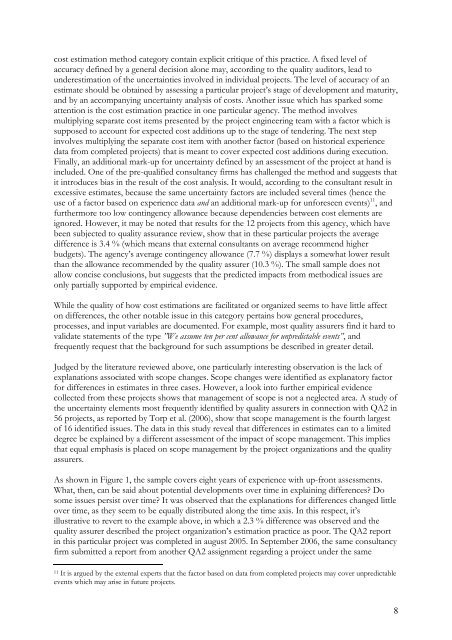Link to thesis. - Concept - NTNU
Link to thesis. - Concept - NTNU
Link to thesis. - Concept - NTNU
- No tags were found...
You also want an ePaper? Increase the reach of your titles
YUMPU automatically turns print PDFs into web optimized ePapers that Google loves.
cost estimation method category contain explicit critique of this practice. A fixed level ofaccuracy defined by a general decision alone may, according <strong>to</strong> the quality audi<strong>to</strong>rs, lead <strong>to</strong>underestimation of the uncertainties involved in individual projects. The level of accuracy of anestimate should be obtained by assessing a particular project’s stage of development and maturity,and by an accompanying uncertainty analysis of costs. Another issue which has sparked someattention is the cost estimation practice in one particular agency. The method involvesmultiplying separate cost items presented by the project engineering team with a fac<strong>to</strong>r which issupposed <strong>to</strong> account for expected cost additions up <strong>to</strong> the stage of tendering. The next stepinvolves multiplying the separate cost item with another fac<strong>to</strong>r (based on his<strong>to</strong>rical experiencedata from completed projects) that is meant <strong>to</strong> cover expected cost additions during execution.Finally, an additional mark-up for uncertainty defined by an assessment of the project at hand isincluded. One of the pre-qualified consultancy firms has challenged the method and suggests thatit introduces bias in the result of the cost analysis. It would, according <strong>to</strong> the consultant result inexcessive estimates, because the same uncertainty fac<strong>to</strong>rs are included several times (hence theuse of a fac<strong>to</strong>r based on experience data and an additional mark-up for unforeseen events) 11 , andfurthermore <strong>to</strong>o low contingency allowance because dependencies between cost elements areignored. However, it may be noted that results for the 12 projects from this agency, which havebeen subjected <strong>to</strong> quality assurance review, show that in these particular projects the averagedifference is 3.4 % (which means that external consultants on average recommend higherbudgets). The agency’s average contingency allowance (7.7 %) displays a somewhat lower resultthan the allowance recommended by the quality assurer (10.3 %). The small sample does notallow concise conclusions, but suggests that the predicted impacts from methodical issues areonly partially supported by empirical evidence.While the quality of how cost estimations are facilitated or organized seems <strong>to</strong> have little affec<strong>to</strong>n differences, the other notable issue in this category pertains how general procedures,processes, and input variables are documented. For example, most quality assurers find it hard <strong>to</strong>validate statements of the type ”We assume ten per cent allowance for unpredictable events”, andfrequently request that the background for such assumptions be described in greater detail.Judged by the literature reviewed above, one particularly interesting observation is the lack ofexplanations associated with scope changes. Scope changes were identified as explana<strong>to</strong>ry fac<strong>to</strong>rfor differences in estimates in three cases. However, a look in<strong>to</strong> further empirical evidencecollected from these projects shows that management of scope is not a neglected area. A study ofthe uncertainty elements most frequently identified by quality assurers in connection with QA2 in56 projects, as reported by Torp et al. (2006), show that scope management is the fourth larges<strong>to</strong>f 16 identified issues. The data in this study reveal that differences in estimates can <strong>to</strong> a limiteddegree be explained by a different assessment of the impact of scope management. This impliesthat equal emphasis is placed on scope management by the project organizations and the qualityassurers.As shown in Figure 1, the sample covers eight years of experience with up-front assessments.What, then, can be said about potential developments over time in explaining differences? Dosome issues persist over time? It was observed that the explanations for differences changed littleover time, as they seem <strong>to</strong> be equally distributed along the time axis. In this respect, it’sillustrative <strong>to</strong> revert <strong>to</strong> the example above, in which a 2.3 % difference was observed and thequality assurer described the project organization’s estimation practice as poor. The QA2 reportin this particular project was completed in august 2005. In September 2006, the same consultancyfirm submitted a report from another QA2 assignment regarding a project under the same11 It is argued by the external experts that the fac<strong>to</strong>r based on data from completed projects may cover unpredictableevents which may arise in future projects.8
















